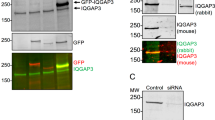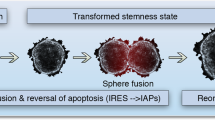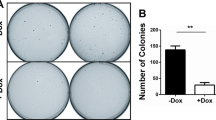Abstract
Ras signaling involves the activation of several downstream pathways that exhibit isoform specificity. In this study, the basal and tumor necrosis factor α (TNFα)-induced activation of NF-κB has been examined in cells overexpressing H-Ras, K-Ras or N-Ras. Cells expressing H-Ras exhibited a basal κB activity that correlated with sustained IκB kinase activation and lower steady-state levels of IκBα in the cytosol. Upon activation with TNFα, the cells expressing the distinct Ras isoforms behaved similarly in terms of binding of nuclear proteins to a κB sequence and induction of a κB-dependent reporter gene. The basal activation of NF-κB in cells expressing H-Ras impaired staurosporine-induced apoptosis in these cells, through a mechanism that was NF-κB-dependent and inhibitable in the presence of z-VAD. Moreover, titration of caspase activation in response to staurosporine showed a significant resistance in cells expressing H-Ras when compared with the void vector or the N-Ras counterparts. These results indicate that the distinct Ras proteins have specific effects on the NF-κB pathway and that this action contributes to protect cells against apoptosis.
This is a preview of subscription content, access via your institution
Access options
Subscribe to this journal
Receive 50 print issues and online access
$259.00 per year
only $5.18 per issue
Buy this article
- Purchase on Springer Link
- Instant access to full article PDF
Prices may be subject to local taxes which are calculated during checkout




Similar content being viewed by others
References
Arsura M, Mercurio F, Oliver AL, Thorgeirsson SS and Sonenshein GE . (2000). Mol. Cell. Biol., 20, 5381–5391.
Baldwin AS . (2001). J. Clin. Invest., 107, 241–246.
Cadoret A, Bertrand F, Baron-Delage S, Levy P, Courtois G, Gespach C, Capeau J and Cherqui G . (1997). Oncogene, 14, 1589–1600.
Campbell SL, Khosravi-Far R, Rossman KL, Clark GJ and Der CJ . (1998). Oncogene, 17, 1395–1413.
Castrillo A, Diaz-Guerra MJ, Hortelano S, Martin-Sanz P and Bosca L . (2000). Mol. Cell. Biol., 20, 1692–1698.
Choy E, Chiu VK, Silletti J, Feoktistov M, Morimoto T, Michaelson D, Ivanov IE and Philips MR . (1999). Cell, 98, 69–80.
De Smaele E, Zazzeroni F, Papa S, Nguyen DU, Jin R, Jones J, Cong R and Franzoso G . (2001). Nature, 414, 308–313.
Delhase M, Hayakawa M, Chen Y and Karin M . (1999). Science, 284, 309–313.
Diaz-Guerra MJM, Velasco M, Martin-Sanz P and Bosca L . (1996). J. Biol. Chem., 271, 30114–30120.
DiDonato JA, Hayakawa M, Rothwarf DM, Zandi E and Karin M . (1997). Nature, 388, 548–554.
Downward J . (1996). Cancer Surv., 27, 87–100.
Fenwick C, Na SY, Voll RE, Zhong H, Im SY, Lee JW and Ghosh S . (2000). Science, 287, 869–873.
Finco TS and Baldwin ASJ . (1993). J. Biol. Chem., 268, 17676–17679.
Finco TS, Westwick JK, Norris JL, Beg AA, Der CJ and Baldwin ASJ . (1997). J. Biol. Chem., 272, 24113–24116.
Folgueira L, Algeciras A, MacMorran WS, Bren GD and Paya CV . (1996). J. Virol., 70, 2332–2338.
Fritz G and Kaina B . (2001). J. Biol. Chem., 276, 3115–3122.
Grana TM, Rusyn EV, Zhou H, Sartor CI and Cox AD . (2002). Cancer Res., 62, 4142–4150.
Henry DO, Moskalenko SA, Kaur KJ, Fu M, Pestell RG, Camonis JH and White MA . (2000). Mol. Cell. Biol., 20, 8084–8092.
Hortelano S, Zeini M, Castrillo A, Alvarez AM and Bosca L . (2002). Cell Death Differ., 9, 643–650.
Jo H, Zhang R, Zhang H, McKinsey TA, Shao J, Beauchamp RD, Ballard DW and Liang P . (2000). Oncogene, 19, 841–849.
Johnson L, Greenbaum D, Cichowski K, Mercer K, Murphy E, Schmitt E, Bronson RT, Umanoff H, Edelmann W, Kucherlapati R and Jacks T . (1997). Genes Dev., 11, 2468–2481.
Karin M . (1999). J. Biol. Chem., 274, 27339–27342.
Lander HM, Ogiste JS, Teng KK and Novogrodsky A . (1995). J. Biol. Chem., 270, 21195–21198.
Lee FS, Peters RT, Dang LC and Maniatis T . (1998). Proc. Natl. Acad. Sci. USA, 95, 9319–9324.
Lin YZ, Yao SY, Veach RA, Torgerson TR and Hawiger J . (1995). J. Biol. Chem., 270, 14255–14258.
Ludwig L, Kessler H, Wagner M, Hoang-Vu C, Dralle H, Adler G, Bohm BO and Schmid RM . (2001). Cancer Res., 61, 4526–4535.
Madrid LV, Wang CY, Guttridge DC, Schottelius AJ, Baldwin ASJ and Mayo MW . (2000). Mol. Cell. Biol., 20, 1626–1638.
Maeno E, Ishizaki Y, Kanaseki T, Hazama A and Okada Y . (2000). Proc. Natl. Acad. Sci. USA, 97, 9487–9492.
May MJ and Ghosh S . (1998). Immunol. Today, 19, 80–88.
Mayo MW, Norris JL and Baldwin AS . (2001). Methods Enzymol., 333, 73–87.
Mayo MW, Wang CY, Cogswell PC, Rogers-Graham KS, Lowe SW, Der CJ and Baldwin ASJ . (1997). Science, 278, 1812–1815.
McCarthy SA, Samuels ML, Pritchard CA, Abraham JA and McMahon M . (1995). Genes Dev., 9, 1953–1964.
McFall A, Ulku A, Lambert QT, Kusa A, Rogers-Graham K and Der CJ . (2001). Mol. Cell. Biol., 21, 5488–5499.
Norris JL and Baldwin ASJ . (1999). J Biol. Chem., 274, 13841–13846.
Olson MF and Marais R . (2000). Semin. Immunol., 12, 63–73.
Pahan K, Liu X, McKinney MJ, Wood C, Sheikh FG and Raymond JR . (2000). J. Neurochem., 74, 2288–2295.
Prior IA and Hancock JF . (2001). J. Cell Sci., 114, 1603–1608.
Shields JM, Pruitt K, McFall A, Shaub A and Der CJ . (2000). Trends Cell Biol., 10, 147–154.
Tang G, Minemoto Y, Dibling B, Purcell NH, Li Z, Karin M and Lin A . (2001). Nature, 414, 313–317.
Umanoff H, Edelmann W, Pellicer A and Kucherlapati R . (1995). Proc. Natl. Acad. Sci. USA, 92, 1709–1713.
Wang CY, Mayo MW, Korneluk RG, Goeddel DV and Baldwin ASJ . (1998). Science, 281, 1680–1683.
Xie QW, Cho HJ, Calaycay J, Mumford RA, Swiderek KM, Lee TD, Ding A, Troso T and Nathan C . (1992). Science, 256, 225–228.
Yan F, John SK and Polk DB . (2001). Cancer Res., 61, 8668–8675.
Yan J, Roy S, Apolloni A, Lane A and Hancock JF . (1998). J. Biol. Chem., 273, 24052–24056.
Acknowledgements
OM, AB and JLO were recipient of fellowships from Comunidad de Madrid, ISCIII and FIS (BEFI), respectively. This work was supported by Grants SAF2002-00783 and 08.3/0030/98 from CICYT and Comunidad de Madrid, respectively, to LB and by Grants BMC2001-0057 and 01/16 from Programa Nacional de PGC and ISCIII (intramural program), respectively, to JMR.
Author information
Authors and Affiliations
Corresponding author
Rights and permissions
About this article
Cite this article
Millán, O., Ballester, A., Castrillo, A. et al. H-Ras-specific activation of NF-κB protects NIH 3T3 cells against stimulus-dependent apoptosis. Oncogene 22, 477–483 (2003). https://doi.org/10.1038/sj.onc.1206179
Received:
Revised:
Accepted:
Published:
Issue Date:
DOI: https://doi.org/10.1038/sj.onc.1206179
Keywords
This article is cited by
-
Bioluminescence Imaging to Monitor the Effects of the Hsp90 Inhibitor NVP-AUY922 on NF-κB Pathway in Endometrial Cancer
Molecular Imaging and Biology (2016)
-
Role of nuclear factor-κ B in melanoma
Cancer and Metastasis Reviews (2005)



